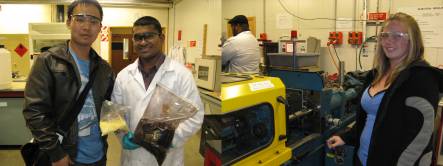 We're used to plastics made from petrochemicals, and even some produced from starches, but a University of Waikato team is investigating ways of producing bioplastic from protein - specifically, from proteins contained in blood. At the moment blood from abattoirs is turned into bloodmeal and sold as low-cost fertiliser, but team leader, engineer Johan Verbeek, hopes that converting bloodmeal into a plastic-type polymer could create a much higher value product. Potential end uses for the product include planting containers, and, if a way can be found to produce a thin film, silage wrap or mulch film. Johan Verbeek, pictured above on left, stands next to student Velram Mohan who is holding thin extruded 'spahgetti' strands of bioplastic.
We're used to plastics made from petrochemicals, and even some produced from starches, but a University of Waikato team is investigating ways of producing bioplastic from protein - specifically, from proteins contained in blood. At the moment blood from abattoirs is turned into bloodmeal and sold as low-cost fertiliser, but team leader, engineer Johan Verbeek, hopes that converting bloodmeal into a plastic-type polymer could create a much higher value product. Potential end uses for the product include planting containers, and, if a way can be found to produce a thin film, silage wrap or mulch film. Johan Verbeek, pictured above on left, stands next to student Velram Mohan who is holding thin extruded 'spahgetti' strands of bioplastic.
Student Talia Hicks has been investigating the biodegradability of the bioplastic, while fellow student Aaron Lowe has been working at reducing the odour of 'blood plastic' and removing colour so that dying becomes an option. Johan Verbeek won a Bayer Innovators Award in 2008 for his work turning waste materials into new products, and a start-up company, Novatein, has already been established to patent and commercial the innovative new process.

Left: Aaron Lowe and Velram Mohan holding bloodmeal: the yellow sample on the left has been de-coloured, while the dark red sample on the right is the bloodmeal's original state. Right: Talia Hicks next to an injection moulding machine (Images: A. Ballance)

